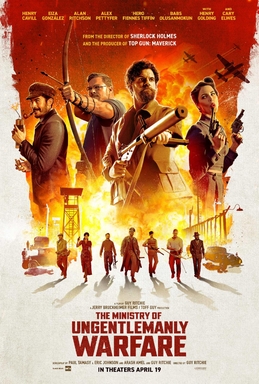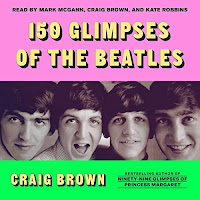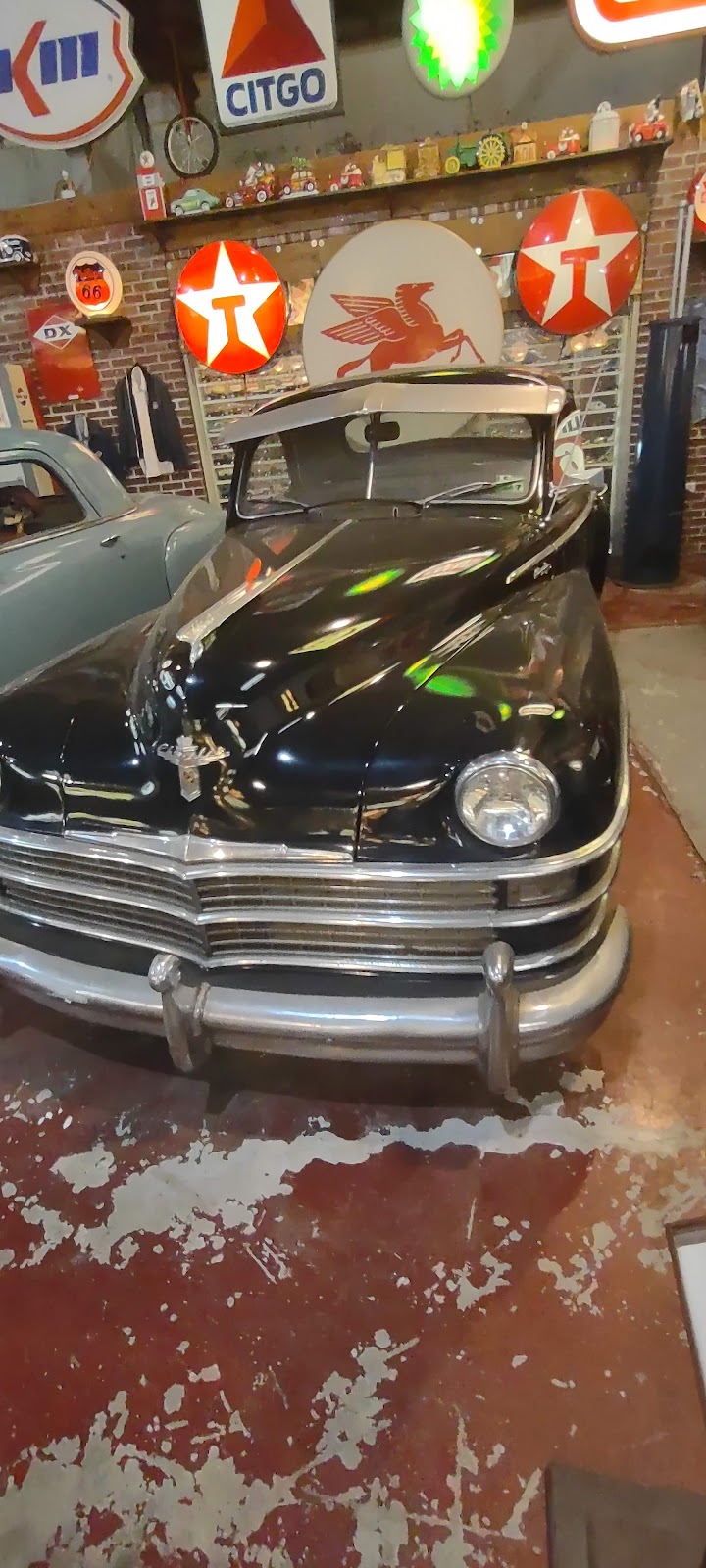Part One: The Trip Up
Friday, May 10
Strong storms passed through Texas just before we left on this trip: tornadoes and flooding and torrential rain. East Texas got over two feet of rain in a short time, and these storms continued to dump water across the southeastern part of the country. But my calculations were that we would be behind the bad weather, and further and further back each day, and it seems I was right. Not a drop of rain so far, and after the first day of clouds, we've had gorgeous spring weather.
Carly went to the kennel early on Friday, and as usual was thrilled to get her paper collar. If we could bring her on these condo trips, I'd gladly leave the Jag behind and drive the Subaru. And in fact, now that I'm so much fatter than before, despite still being only 49 years old, I'm close to the point of giving my little convertible to a car museum anyway. (If I thought any of my heirs were the least bit interested in it, I'd give it to them, but they're not. It's not their style.)
So we were off. We stuck to I-10 all the way through Houston, listening to The Ink Black Heart, the sixth book in J.K. Rowling's "Cormoran Strike" series of mysteries. Like her Harry Potter series, each book is longer than the one before. This one -- the first we've listened to rather than reading -- is 33 hours long, so we won't finish it until the return trip. We enjoy the series: the regular characters are well-developed and likable, the plots are complex without being impenetrable, the language is precise and the tone is just slightly erudite. They're written for people who paid attention in school.
East of Houston, we stopped for lunch in a Vietnamese noodle house called Vietnamese Noodle House. It was simple and downscale but the food was good, plentiful and cheap. Service was so-so and the restaurant itself was utterly unprepossessing, but I'd go back if I'm ever looking for lunch around there. (I won't be.) I'd planned, at that stage of the trip, to take the old highway as far as Beaumont, but Google Maps showed some kind of blockage ahead on that route, so back to I-10 we went. (That stretch of I-10 between Houston and Beaumont still holds the title of Dullest Freeway in the US, as far as I'm concerned.) We got off the interstate just east of Lake Charles and headed up through Alexandria to Natchez, where we spent the first night in a reasonably priced hotel that claims to be a 3-star place but really only gets two. We got our room key and found a parking spot nearby, then opened the room to find somebody else's luggage and shopping all over the room. The desk clerk blamed housekeeping, and I'm not giving a lot of thought to how it could be their fault. The replacement room was in the same general area, so it was no trouble to unload the car from where it was.
Then we headed Under the Hill. That's the part of Natchez, right along the riverbank at the bottom of the bluff, where the riverboats used to dock. Well, they still do, and there was actually one in the port, a stern-wheeler whose name I didn't catch. Lights were on in some of the rooms on board and you could tell that they were elegantly appointed. Makes me want to try a river cruise, but I would like to do that somewhere with less humidity and fewer mosquitos.
 |
| sunset on the Mississippi at Natchez |
Anyway: Natchez Under the Hill, years ago, was what we would call a red-light district: whorehouses, and saloons, mostly, plus warehouses and flophouses. Now, of course, it's all gentrified. Not a big area, but big enough for a few nice bars and restaurants, it's the center of night life for upscale Natchez. I hadn't been down there in about 40 years, so I was curious to see it again. We had a very pleasant dinner at a sports pub called The Camp, then went back to our hotel, where we were slightly relieved to find our own belongings undisturbed.
Saturday, May 11
In the morning I had a cup of very bad coffee, most of which I threw away because of the bugs swarming around me while I tried to drink it, then we drove up the highway to Port Gibson, to see a goldfingered church steeple and grab some breakfast. Found the steeple, but turns out there are no restaurants in Port Gibson. (McDonald's doesn't count.) So we dove into our ice chest and had hard-boiled eggs and apples for breakfast while lamenting the primitive resources available in rural Mississippi.
 |
I had some trouble getting Google Maps to take me along the route I wanted, and we ended up passing through Jackson first on freeway, then on a six-lane divided highway. We stopped for lunch somewhere along the road there, in a new-ish cafe in a strip center, where the service was excellent, the menu was very short and the prices were reasonable. We each ordered salads, but when the servers carried the daily special fried chicken plates by for the folks at the next table, I knew I'd made a mistake. I'm still suffering. The salad was okay but, Man! did that fried chicken look good! I suspect it will backfire on me at some point in this trip.
After that, we made a stop in a podunk little town called Shubuta (or Shubula; sources disagree) to drink some red water out of their "famous" red water artesian well. Shubuta (or Shubula) isn't actually a town, it's more a community that used to have a police force (we saw the car) and now is a convenience store, a bunch of abandoned businesses, and this artesian well. Iron-laced water bubbles up out of the ground into a 30-gallon pot, then flows into a small concrete coy pond, then drains into the ground, forming a nice breeding ground for Mississippi's state bird, the Mosquito.
The water was not as tasty as the iron-laced water we used to get from the pump at my grandparents' farm in Pumpkin Center sixty years ago. And not as much fun, because you don't have to pump it yourself.So that was as much of a roadside attraction as I could find to justify taking the back roads across Mississippi and Alabama. From there we drove over to Monroeville, Alabama, the "literary capital" of that state, so called because both Harper Lee and Truman Capote were born there. There is, it appeared, nothing to see after business hours, because the Old Court House, which we were assured would look just like the courtroom set constructed for the film version of To Kill a Mockingbird shuts down at 5pm. We didn't really care. We had dinner in the Court Cafe -- I had an excellent shrimp po-boy and fries, and we picked up scones for the next day's breakfast -- and drove up the road to Montgomery, where our hotel was.
Sunday, May 12
Last time we went through Montgomery we stopped at the Peace and Justice Memorial, a very moving place, and then went to the Legacy Museum; but we got there too late to see the whole thing. So our plan was to stay the night in Montgomery, then finish viewing the museum Sunday morning. That's exactly what we did; we got there just after it opened at 9AM, We were there until about noon, and still kind of rushed the last part of it.
 |
| too on-the-nose |
We drove top-up to Auburn, where we wasted half an hour seeing the Jule Collins Smith Museum of Fine Art. There was no fine art there, just a few small galleries of postmodern race-sensitive crap. I'm sure it's very popular with the white-guilt woke arts community, but it's nothing I'd look twice at. Well, there was one sculpture, a wall-mounted piece with an old sailing ship model stuck into a lobster trap. If it had had a title like "Slave Ship" I'd have thought it was an excellent metaphorical representation of how 250 years of the slave trade, and its later consequences, still traps all of American society; but no, it was called something that related to a protégé of the sculptor, and so was meaningless to any large purpose.
It was too early for dinner when we passed the Whistlin' Pig Cafe, which is reputed to have the best Brunswick Stew in all of Georgia ... why that should be a thing, I don't know ... but it's OK; it's closed on Sundays anyway. We drove up the mountain to see Franklin Delano Roosevelt's favourite picnic spot, right behind the CCC-built headquarters building for FDR State Park. (He used to come to that spot when he was at Warm Springs, which is just a few miles further east from there.) It was, as you might expect what with the presidential imprimatur and all, a nice view, but I didn't consider it photo-worthy, as I already have way too many photographs of indistinguishable broad forested valleys dotted with the occasional unidentifiable building in the distance.
For reasons I no longer remember, I'd decided to bypass Warm Springs, so we got on the freeway and headed north, hoping to bypass Atlanta traffic congestion completely while Mothers' Day was still in force. We didn't entirely succeed at this, as apparently one of the big things to do in that area on Mothers' Day is go watch the Braves play wearing pink gear. We also had to go right past Harts Field, the world's busiest airport, so there was a stretch of traffic to deal with. But all in all it wasn't that bad. We got out to the northwest suburbs while it was still broad daylight, and headed for Morgan Falls Overlook Park, which turns out to be a popular city park with a playground stuffed full of little kids, more than I've seen in one place since I was one myself. Unfortunately it has no waterfalls, and thus no overlook thereof. There used to be a waterfall, but it's now under the reservoir formed by a dam erected by the local power company on the Chattahoochee River. Well, I got some exercise while making this determination.
We spent the night in Roswell, not quite beyond the reach of the Atlanta Metropolitan area, after having a late supper at a very good place called North River Tavern. It seemed about to close when we arrived, but by the time we left it was pretty well hopping, except that everyone was out on the patio. We were the only customers sitting inside, I think. I had a side salad and we split an order of hot dogs. (I don't know why I've been craving hot dogs lately, unless it's because I keep passing the Dog Father restaurant on San Pedro and wondering how it can have stayed in business for so many years.) My side salad ($2.95) was more like a chef's salad, and I could barely eat my hot dog afterwards. The dogs (two in the order) came with fries, which were, dare I say it? I dare: perfect. They were perfect. Crinkle cut, perfectly fried, and not too much salt.
Monday, May 13
 |
| The cabbage patch |
(Which reminds me -- the MTG reference, not the cabbage patch: in three days' driving across the Deep South we've seen exactly one Trump sign. I take it as a hopeful indication that, this close to a presidential election, the people who avidly supported the Great Orange Child in the past seem reluctant to let their neighbours know. May God bless and save the United States.)
 |
| Anna Ruby Falls |
Well, that was a really nice interlude, with more exercise than I've gotten since my heart attack last Christmas. I was relieved to make it to the top, and I was relieved to see that they had frequent benches available all the way up (though I only needed them twice, if I recall correctly.)
After that, we stopped in at the Northeast Georgia Folk Pottery Museum, which has a nice, albeit small, exhibit showing the history of pottery in the area, which has been going on for about 200 years. In the earliest days, pottery was a basic necessity. "If a man couldn't put up 50 or 60 gallons of syrup" (the only sweetener available back then) "his family wasn't gonna make it through the winter." Later on, as glass storage jars and factory-made pottery became available, and new products like granulated sugar and molasses made it into the hills, pottery became more decorative, less of a necessity, and relatively cheaper.
On the other side of the building is a series of art galleries. I walked into the first room and found eight things I wanted to buy. I stopped looking. That makes nine artisan works on this trip that I regret not having bought. Of course, the decisive question in my mind has become, Where would I put it? And there, I have me. I have no place left in my house to display a vase or a pot or a small wall hanging. I live in too much clutter. (I will, at this point, refrain from specific critiques of the habits of other members of the household in connection with available flat surfaces at home.) (Yes, Carly is something of a slob.)
 |
| wooden Model T model |
It was too late in the day to visit Tallulah Gorge State Park, which from the descriptions I've read is a must-see sort of stop; but it shuts down at 5pm sharp. One wonders why. So we didn't get to use our $5 Georgia State Parks parking pass, and I still want vengeance for that.
Tuesday, May 14
First thing this morning after breakfast (at a popular cafe called The Rusty Bike, where I decided I didn't have to eat the entire breakfast burrito) we drove up the road to the one attraction on the trip that Sherry has actually gotten excited about seeing: the Foxfire Museum, in the tiny town of Mountain City. I'm sure all the world of a certain age remembers the Foxfire magazine that recorded the history and lifeways of the Appalachian Mountain settlers and their descendants; it was put together by a bunch of school kids in the Rabun County area of Georgia, kids who were concerned that these ancient ways were being lost to modernity. The magazine's articles were collected in a series of best-selling books; the royalties from the books enabled the group to buy some land, relocate a bunch of Appalachian buildings -- cabins, barns, mills, etc. -- and those buildings now comprise the Foxfire Museum, a sort of Living History project where people can come and see how to grind corn or make buckets or do smithing and whatever.
Of course, early on a rainy Tuesday morning there weren't any volunteers there to man the various buildings and studios, so we just walked slowly up the hill, the only people there at that time of day, looking in each building (if it was unlocked), then back down the hill. It took us not quite an hour. Sherry enjoyed it pretty thoroughly; I was nonplussed, as (1) I'd never been a fan of the Foxfire stuff as a kid in the 1970s when this was all popular, and (2) after a year and a half living in West Virginia, where time moves much more slowly, so a year and a half counts as twenty-five years of normal life, I'd seen all the ramshackle cabins and 'shiner stills and axe handles I care to see. I've been in enough log cabins, barns and sheds, most of them much older that those at Foxfire, and most of them still in regular use, and cluttered with people and things, and seen enough of the lifeways of poverty-stricken Appalachians. And I've been to enough Living History museums, from Louisbourg to Sturbridge to Acadian Village, to keep me satisfied for the remainder of my days.
 |
| Bridal Veil Falls |
From there, it was up to the airport at Asheville to collect Nancy and Jeff. We are now ensconced in an Asheville hotel for the night. We had dinner at a nice restaurant a couple of miles down the road and will get an early start tomorrow, driving in a roundabout way to Knoxville, where we'll spend three nights before heading to our condo week east of Asheville. Tomorrow will start Part 2 of this blog post.
And by the way, as usual all my pictures from this trip are available for viewing in my Google Photos albums, "2024-06 Lake Lure Trip". All of my pictures, I believe, are captioned, so you don't have to just guess at what you're looking at. In some applications, the captions show at the bottom of the photo; otherwise, when you view the pictures in Google Photos, you'll see a little "Information" icon at the top right -- an "i" in a circle. Click on that to read the captions.













